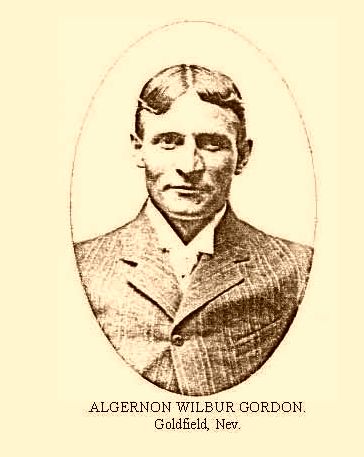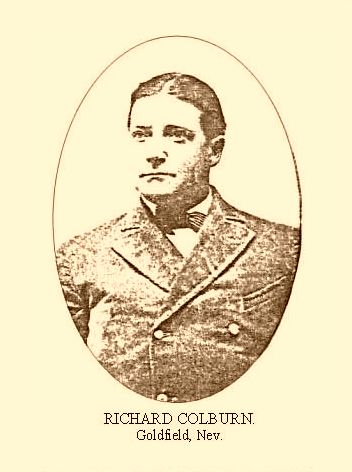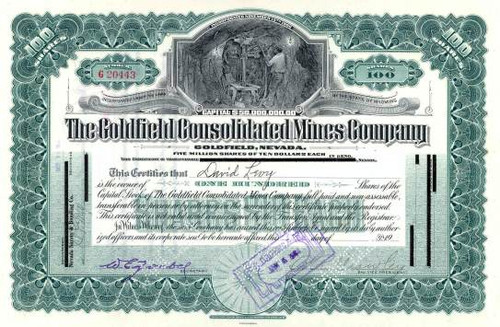Beautiful certificate from the Manhattan Consolidated Extension Mining Company issued in 1907. This historic document has an ornate border around it with a vignettes of mining scenes. This item has the signatures of the Company's President, Gurney Gordon and Secretary, R L Colburn. 
Certificate Vignette Article printed in AUGUST, 1906 from "SUCCESSFUL AMERICAN PORTAITS AND BIOGRAPHIES OF PROMINENT ENGINEERS, MINERS AND BUSINESS MEN OF NEVADA" ALGERNON WILBUR GORDON (Gurney Gordon) 
President of the Manhattan Consolidated Extension Mining Company of Goldfield It is a fact that mining is the greatest of all creative industries, and it may truly be added that to it is directly due the nation's present prosperity. It was indeed the immense treasure-houses of California gold and Nevada which enabled this nation to triumph in the sixties in the longest, bloodiest war of modern times, and rendered possible quick recuperation from the exhaustive struggle. It was the mines of California that caused the speedy settlement of one of the most productive States Of the Union, and the same cause is responsible for transforming the vast plains and desolate hills of Nevada into hives of industry. Among the early pioneers of this great transformation, and one who brought with him skill and experience developed in other mining districts, is the subject of this sketch ; and for his good work in this respect he has realized, deservedly prosperous results, and we take great pleasure in giving him due honor with other sturdy pioneers, whose biographical sketches appear in the current number of SUCCESSFUL AMERICAN. Of Scotch-English descent, the subject of this sketch, familiarly known as Gurney Gordon, (and, as a matter of fact, in all business transactions he so signs his name), was born at Warren, Ohio, on November 24, 1874. He is a son of Zachariah and Ann Maria Gordon, his father being a noted farmer of the Buckeye State. He is a nephew, on his mother s side, of J. E. Pickering, for many years a leading judge of the District Court of Ohio. Mr. Gordon received a liberal education in public schools and other institutions of learning in Nebraska, obtaining thereat a technical knowledge of mining which when the opportunity come to put it to a practical test resulted in great advantage to him in after life. His first venture in mining and prospecting was in Montana, where he made a business of examining mines, reporting on them, and operating them. His stay in Montana was productive of very satisfactory results. He acquired a one-half interest in what is known as the Top Hand Group of Mines, his brother owning the other half, and he also owns a one-third interest in the Tenderfoot Mine. Both of these properties are near Pony, about sixty miles from Butte, and have been rich producers of ore. In Goldfield, Nev., Mr. Gordon is interested in the Rep Top Mine, in the development of which he had as co-operators W. E. Hughey, C. D. Taylor, R. L. Colburn, and H. L. Taylor, and he is President of the Manhattan Consolidated Extension Mining Company ; President also of the Round Mountain Red Top Mining Company, and Vice-President and General Manager of the Fairview Gordon Boulder Mining Company, of Fairview, some of the samples of which run nearly two-thirds pure gold. Fairview, in Churchill County, is indeed the location of some of the richest strikes in the history of Nevada. Mr. Gordon is a gentleman of great generosity of nature. He belongs to that class of men who receive friends with a quiet cordiality which is thoroughly sincere in every respect, and which means no more and no less than is outwardly exhibited. Such are the qualities of a true gentleman. Mr. Gordon is an old member of the Independent Order of Odd Fellows, and is a charter member of the Montezuma Club of Goldfield, the leading club of that now far-famed mining district. RICHARD LINCOLN COLBURN 
Another of Fortune's Favorites in the Gold Region of Nevada. RICHARD LINCOLN COLBURN, son of Rev. Nathaniel Wesley and Mary Elizabeth (Johnson) Colburn, is a native of Mifflinsburg, Pa., and was born on May 11, 1866. On his father's side he is of English descent. His mother was from old Puritan stock. Owing to the change of abode incident to a minister's family, young Colburn had a sort of piecemeal education in several localities ; but he was an apt scholar as well as an ambitious lad, and when he reached his fifteenth year, he started out like a brave boy to earn his livelihood, and his first venture was as assistant ticket agent for the Pennsylvania Railroad Company at Newport, Pa., and later on he entered the employment of the Lehigh Valley Railroad Company at Packertown, Pa. Before long the possibilities of the Empire City loomed up before his eyes, and going to New York he became an employee of the banking firm of Harvey Fisk & Sons on Wall Strtreet. During 'eleven years' service in that capacity he gained, besides many educational advantages, large financial experience and felt himself fully qualified to face the "wild and woolly West," where all the gold with which he had been so long surrounded came from, and thus he became interested in mining at Salt Lake City, Utah, but he did not there find that realization of bright hopes which he had expected, for, while his abilities enabled him to make money he struck "a hard streak of luck," and when, in 1903, the marvelous discovery of gold in Goldfield, Nev., reached his hearing, he was not slow in making a start for that locality, where Dame Fortune gave him a most gracious welcome. Mr. Colburn does not hesitate to tell those who know him how hard up he was when he changed his location from Salt Lake City to Goldfield. "I was down and out," he says. "My bankers in Salt Lake City were T. R. Jones & Co., and when they went broke, I went with them. The securities that I had left depreciated in value, until I found myself $17,000 in debt to Salt Lake bankers. But I still had a diamond ring and on that I managed to borrow $110, which brought me to Goldfield." If Mr. Colburn had no money, he at least had vim and vigor, and what was better still, a knowledge of mines and mining. Luck was with him from the time he set foot in Goldfield. He began by locating claims all over the district. He had them near the Black Butte and Quartzite mines at one end of the golden horseshoe that marks the outline of the Goldfield mining country ; he had them on Columbia mountain, at the bend of the horseshoe ; and he had still others near the Dixie, at the other end. He staked them out and did all the assessment work himself. Some of them he sold for little or nothing, and these have since become worth millions. But that is part of the chance a bankrupt man has to take in a mining camp. But, as the habitues of the mining district say, he came out "hunk." Mr. Colburn's mining experiences is so interesting that we cannot resist adding in his own words his brief recital of the "streak of good luck" he had in Nevada as an offset to his experience in Salt Lake City. "I was out on Lone Mountain," he says, "looking after a piece of property for people in Salt Lake City. We had camped, and while there two men came up and wanted to pitch their bunk with us. We had no room in the tent, but told them they could put their bed at the side to shelter them from the wind. They were Charles D. Taylor and George McClellen, now the owners of the rich Jumbo mine." "Later on, while coming in from that section with a mule team, I overtook a man plodding along the dusty road with a pack on his back. He had been to Cloverdale, and on his return trip his horse had broken down. To save his own life he had started to walk in. It was Taylor again, and I helped him into camp. When I next met him he was going to prospect out in the Grandpa district, and said: "All I need is $50 to buy grub. If you will let me have it, I will give you half of all I get. As a matter of fact, I didn't have the money. But he managed to get it elsewhere. If I had been able to stake him then, I would have had an interest in the Jumbo, to-day worth a million. "There was little luck for me, however, after that. When I met Taylor again for the third time, he had located his claims but had not had them surveyed because he did not have the ready money. I said I and my partners would survey them for an interest. He jumped at the proposition and we surveyed all the claims of the great Jumbo group. Meanwhile we prospected over the ground to see what part we should take for ours, and we selected the Red Top, for which Taylor had paid only $35. We took half of that claim in payment for the surveying, and I guess we could have had the whole of it for the asking. I got 100,000 shares for my part when the company was incorporated and the same amount went to each of my partners. I am inclined to think we were pretty well paid for our work. But somehow I still regret my lack of that $50 and the Jumbo." Mr. Colburn, it is almost needless to say, is now very comfortably fixed. He is Secretary and Treasurer of the Red Top Mining Company of Goldfield, the Manhattan Consolidated Extension Mining Company, the Round Mountain Red Top Mining Company, the Hill Top Mining Company of Bullfrog, and President of the Goldfield Bullfrog and is also interested in a number of other propositions in Southern Nevada and the Kimberly group of claims in the Fairview district. R.L. (Dick) Colburn is also the founder of R.L. Colburn & Company, Bankers & Brokers of Goldfield, Nevada. Mr. Colburn, who was a member of the Republican Club of New York, while in that city, is now a member of the Atlas Club of Salt Lake City, the Mizpah Club of Tonopah, the Montezuma Club of Goldfield, and the Olympia Club of San Francisco ; and he is also a member of the Benevolent and Protective Order of Elks. Mr. Coburn was married in San Francisco on May 31, 1905, to Miss Rose Estelle Butler.

Certificate Vignette










